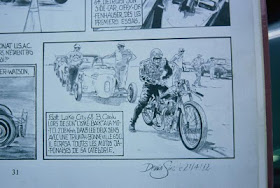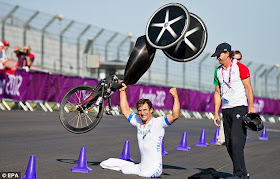Ten years ago, I was in Paris at a vintage bike show. A gaggle of French bikers were gathered around an old Triumph, elbowing each other and pointing at it.
I heard one say, “C’est le monster du lac salé!”
 |
| French cartoonist Denis Sire, with bike builder Laurent Romuald in background. |
That piqued my curiosity, so I asked the owner–a guy named Laurent Romuald–if the bike was an old Salt Flats racer. “No,” he told me wistfully, “but it’s my dream to run it on the Bonneville Salt Flats.”
 |
| Romuald's replica. This bike is known to thousands of French bikers as, Le monstre du lac sale |
They say art imitates life, but Laurent’s bike was a case of life imitating art imitating life. His bike was a replica of one that figured in a comic book written and illustrated by Denis Sire. Sire was an avid motorcyclist and a popular ‘bande desinée’ artist in the ’70s and ’80s. His stories were set in Rock ’n Roll-era America–hot rods, flat track, desert racing, Buddy Holly; he loved that stuff.
 |
| Denis Sire, in his Paris studio. |
 |
| This was the photo that Sire used for inspiration. That's '60s drag ace Nira Johnson, on the bike. |
One day while he sat in his studio seeking inspiration, he flipped through an old car magazine and found a photo spread, of action on the Bonneville Salt Flats from 1967. A single, grainy, black and white photo of a guy on a Triumph motorcycle, captioned with the name ‘Nira Johnson,’ caught his imagination. With nothing else to go on, he made up a little story about an American racer with that name, and a fast Triumph he dubbed, ‘Le monstre du lac salé’. That translates as, the Salt Lake monster. (Salt Lake and the Salt Flats are a hundred miles apart, something Sire might have known if he’d ever actually been to the United States.)
 |
| A spread from Sire's bestselling graphic novel 6T Melodies, with detail of the drawing, based on the old photo of Nira, below... |
The story appeared in a comic book called 6T Melodies. It was so popular that Laurent decided to build a replica of the bike in the comic. I was born in 1959,” he told me, “the same year as the Bonneville.” He grew up to become one of the top French experts on British twins, with a beautiful shop on the outskirts of Paris called Machines et Moteurs. He called Denis Sire to tell him his plan.
“Good luck,” Sire told him. Then he explained that he’d made it all up based on a single old photo. “But,” he went on, “I think I still have the magazine, I’ll bring it over.” The two were soon fast friends. They blew up the magazine photo but there wasn’t much detail to be seen there. They also searched for any mention of Nira Johnson in other old magazines, hoping to trace him, but came up empty. So in the same way that Sire had imagined his American stories, Laurent had to imagine the bike.
“I could see it was an early Bonneville motor in a rigid frame,” he told me. “It looked like a drag bike, so as I built it, I asked myself ‘What would an American drag racer have done in the ’60s?’” The French have held America in special regard since the days of Lafayette; deep in their subconscious, they see the American Revolution as the one that worked. I loved the idea of these two French guys creating an in-the-metal version of an imagined bike, ridden by an imagined rider, in an imagined version of the ’States.
I promised them that I’d do what I could do to help them live out their fantasy about bringing their bike over to run it on the Salt Flats. When I got back here, I did my own search for Nira Johnson and also drew a blank. I wrote about Laurent, Denis, and le monstre du lac salé on my blog, and forgot about them for years.
Then, out of the blue, I got an email from a stranger that read, “I’m a friend of Nira Johnson, and I have his old motorcycle. Call me.”
 |
| Nira Johnson, at MMP in 2008, with his bike (now in the collection of Rodd Lighthouse.) |
I just about crapped. The stranger–a consulting engineer and AHRMA racer from Nevada named Rodd Lighthouse–had grown up with Nira as a family friend. He’d recently convinced Nira to sell him his old bike. He told me that Nira had been quite a successful drag racer in Southern California in the ’60s. “You may not know that he was a black man,” he added.
He gave me Nira’s phone number, and I called him up. He laughed when I told him that he was famous, at least to French motorcyclists, as a white guy.
I finally got the American side of the tale, from Nira Johnson himself, in September, 2008. The occasion was a round of the American Historic Racing Motorcycle Association’s road racing championship, held at Miller Motorsports Park, about twenty miles from Salt Lake City, in Utah.
Nira was there, doing a little wrenching for Rodd Lighthouse and his dad, Ken. Since they knew I was coming to the race, they brought along Nira's old bike, which was known to thousands of French bikers as ‘Le monstre du lac salé’.
Nira was born in New York of African-American and Native-American parentage. He went to a vocational-technical high school, and joined the Air Force after graduating. He flew on B-36 strategic bombers.
“That’s when I got into motorcycles,” he told me. “I learned as I went. I threw a primary chain through a case when I had my first BSA. An Air Force buddy had a background with hot rods. He was from California, and probably inspired me move to California when I was discharged.”
In ’58, Nira did just that. He got a job at an aerospace company that became Rockwell International, where he helped make Minuteman missiles, and hold the Russkies at bay. In his spare time, he hung with two bikers who raced a twin-engined Triumph dragster they’d bought from Joe Dudek, a legendary Los Angeles tuner. One day when their rider–a fellow named Bill Johnson–didn’t show, they said, “You’re about the same size as him, why don’t you ride it?”
 |
| Johnson only went to Bonneville once. His natural habitat was the SoCal drag scene. Note the exquisite front engine plates. Keepin' it light! |
Nira was hooked. He bought his own bike in ’63, from a guy who’d started to build it then lost interest. What he acquired was basically a rigid, pre-unit Triumph frame that had a Cub front end and a tiny, trick fuel tank with no filler cap. He bought a few hot rodding books and built his own 650cc motor. Another famous tuner named Shell Thuett had one of the only dynos around, and Nira did a lot of his tuning in Thuett’s shop.
“I liked to keep things reliable,” he recalled. “The pre-unit Bonnevilles had a three-piece crank, and when they went to unit construction, they put in a better, two-piece one. So I used that. I polished it, and took off some weight. I ported it; lightened and polished the rods… I wanted to put in bigger valves but it was too expensive.”
His bike wasn’t overly powerful; he remembers it making about 56 horsepower, but it was light. He even thinned all the gears in the transmission. And, it was reliable; in six years of racing it almost every weekend, he blew up one motor.
“I ran what they called Class B/Gas. In the beginning I ran in the high 11-second range, with trap speeds around 110 mph. At the end its development, the bike was hitting 116-118 mph. Sometimes, when other guys saw that I was there, they’d just roll their bikes right back onto their trucks and go home!”
The time that Nira was photographed on the Salt Flats was the only time he ever raced there. “I was using Harmon-Collins cams, and they had some they said were ‘too radical for drag racing’ so I got them to grind me some of those. Other than that, I just swapped the rear tire and gearing. My bike ran good, but the record was set by Dudek and Johnson, at speeds that were unattainable on gas–they were either running alcohol or fuel–so they ran in the high 140s, and my best runs were in the 130s.”
Not long afterwards, Nira moved to the East Coast for his job, and he had no time to drag race. Ironically, he traveled to France for work in 1983, when Denis Sire’s comic book was a best seller.
“I had no idea I was a character in a comic book over there, until Rodd clued me in,” he told me, adding–surely an understatement–“I was kinda’ surprised.”
This is why I don’t write fiction. You couldn’t make this stuff up.
The first half of this story was one of the first Backmarker columns that I posted on the old RoadRacerX.com site. Even that part of the story was cool enough that, when I returned to the U.S. from France, I hoped to get a documentary filmmaker sufficiently interested to bring the replica 'monster' to the Bonneville Salt Flat. When the blog post about the replica resulted in my finding the original monster - and Nira - I updated the post and again begged documentary filmmakers to get in touch with me.
Well, after all these years, I'm now working with Tom Guttry, a veteran producer of documentary and reality TV content, to bring Monsters of the Salt to the screen. Tom recruited Kevin Ward, the cinematographer who shot 'Dust to Glory', and the three of us agreed to work on this film for free, in order to ensure that this heartwarming and inspiring story gets told while Nira (who is in his 80s) is still alive. I got back in touch with Nira, Laurent, and Denis to make sure they were all still interested, and still had access to their bikes. They're all game.













